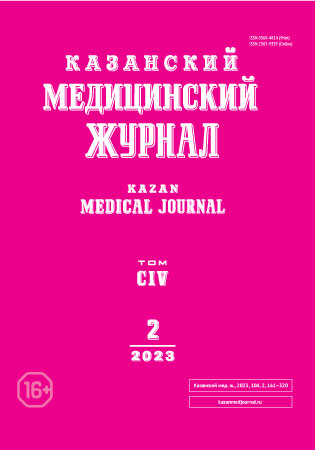Факторы иммунного микроокружения и состояние внеклеточного матрикса при раке вульвы
- Авторы: Златник Е.Ю.1, Ульянова Е.П.1, Непомнящая Е.М.1, Абдуллаева Н.М.1, Вереникина Е.В.1
-
Учреждения:
- Национальный медицинский исследовательский центр онкологии
- Выпуск: Том 104, № 2 (2023)
- Страницы: 207-215
- Раздел: Теоретическая и клиническая медицина
- Статья получена: 11.07.2022
- Статья одобрена: 16.02.2023
- Статья опубликована: 26.03.2023
- URL: https://kazanmedjournal.ru/kazanmedj/article/view/109286
- DOI: https://doi.org/10.17816/KMJ109286
- ID: 109286
Цитировать
Полный текст
Аннотация
Актуальность. Прогрессирование злокачественных опухолей, включая рак вульвы, во многом зависит от состояния внеклеточного матрикса и иммунного микроокружения опухоли, исследование которых для выявления прогностически наиболее значимых из них — актуальная проблема онкологии.
Цель. Оценить экспрессию факторов внеклеточного матрикса и локального иммунитета, а также их взаимосвязи при раке вульвы с различной распространённостью.
Материал и методы исследования. Ретроспективное исследование выполнено на опухолях вульвы 56 больных с I стадией (n=20), II стадией (n=26) и рецидивами (n=10). Иммуногистохимическим методом определяли экспрессию маркёров внеклеточного матрикса (матриксных металлопротеиназ ММР-2 и ММР-9, тканевого ингибитора металлопротеиназы-2 TIMP-2) и локального иммунитета (FOXP3, CD68, CD206). Для статистической обработки использовали U-критерий Манна–Уитни и множественный корреляционный анализ с вычислением парных и частных коэффициентов R.
Результаты. Глубина инвазии оказалась более информативной для обнаружения разнонаправленных различий экспрессии ММР-2 и TIMP-2, чем стадия. Инфильтрация СD68+-макрофагами в строме нарастала параллельно стадии и не различалась при разной глубине инвазии, инфильтрация макрофагами М2 (СD206+) увеличивалась при II стадии по сравнению с I стадией (Ме 13 и 5 соответственно, р=0,03). Различия отмечены только в строме опухолей, как и возрастание T-regs (FOXP3) при увеличении глубины инвазии (Ме 25 и 8 соответственно, p=0,0359). По мере нарастания распространённости опухоли увеличивается количество корреляционных взаимосвязей между показателями локального иммунитета паренхимы и стромы опухоли: выявлено 2 статистически значимых корреляции, не зависящих от ковариат, 7 зависящих от стадии и 6 зависящих от глубины инвазии. Корреляции факторов иммунного микроокружения с внеклеточным матриксом ослабевают.
Вывод. Уровни MMP-2, TIMP-2, CD68+, CD206+, FOXP3 отражают процесс прогрессирования рака вульвы и могут быть использованы для прогнозирования течения заболевания; инфильтрация опухолей макрофагами, Т-regs характеризует скорее стадию первичной опухоли, чем рецидив.
Полный текст
Об авторах
Елена Юрьевна Златник
Национальный медицинский исследовательский центр онкологии
Автор, ответственный за переписку.
Email: elena-zlatnik@mail.ru
ORCID iD: 0000-0002-1410-122X
докт. мед. наук, проф., главный научный сотрудник, лаб. иммунофенотипирования опухолей
Россия, г. Ростов-на-Дону, РоссияЕлена Петровна Ульянова
Национальный медицинский исследовательский центр онкологии
Email: uljanova_elena@lenta.ru
ORCID iD: 0000-0001-5226-0152
науч. сотр., лаб. иммунофенотипирования опухолей
Россия, г. Ростов-на-Дону, РоссияЕвгения Марковна Непомнящая
Национальный медицинский исследовательский центр онкологии
Email: evgeniyamarkovna@mail.ru
ORCID iD: 0000-0003-0521-8837
докт. мед. наук, проф.
Россия, г. Ростов-на-Дону, РоссияНина Магомедовна Абдуллаева
Национальный медицинский исследовательский центр онкологии
Email: kurbanovanina416@gmail.com
ORCID iD: 0000-0002-7364-1963
мл. науч. сотр., отд. опухолей репродуктивной системы
Россия, г. Ростов-на-Дону, РоссияЕкатерина Владимировна Вереникина
Национальный медицинский исследовательский центр онкологии
Email: iftrnioi@yandex.ru
ORCID iD: 0000-0002-1084-5176
SPIN-код: 6610-7824
докт. мед. наук, зав. отд. онкогинекологии
Россия, г. Ростов-на-Дону, РоссияСписок литературы
- De Smedt L, Palmans S, Andel D, Govaere O, Boeckx B, Smeets D, Galle E, Wouters J, Barras D, Suffiotti M, Dekervel J, Tousseyn T, De Hertogh G, Prenen H, Tejpar S, Lambrechts D, Sagaert X. Expression profiling of budding cells in colorectal cancer reveals an EMT-like phenotype and molecular subtype switching. Br J Cancer. 2017;116(1):58–65. doi: 10.1038/bjc.2016.382.
- Herbster S, Paladino A, de Freitas S, Boccardo E. Alterations in the expression and activity of extracellular matrix components in HPV-associated infections and diseases. Clinics (Sao Paulo). 2018;73(1):e551s. doi: 10.6061/clinics/2018/e551s.
- Kortekaas KE, Santegoets SJ, Abdulrahman Z, van Ham VJ, van der Tol M, Ehsan I, van Doorn HC, Bosse T, van Poelgeest MIE, van der Burg SH. High numbers of activated helper T cells are associated with better clinical outcome in early stage vulvar cancer, irrespective of HPV or p53 status. J Immunother Cancer. 2019;7(1):236. doi: 10.1186/s40425-019-0712-z.
- Неродо Г.А., Новикова И.А., Златник Е.Ю., Непомнящая Е.М., Дженкова Е.А., Иванова В.А., Вереникина Е.В., Ульянова Е.П., Таджибаева Ю.Т. Прогностическая значимость некоторых иммуногистохимических маркёров у больных раком вульвы. Известия вузов. Северо-Кавказский регион. Естественные науки. 2017;(4-2):96–104. doi: 10.23683/0321-3005-2017-4-2-96-103.
- Кит О.И., Неродо Г.А., Непомнящая Е.М., Новикова И.А., Ульянова Е.П., Иванова В.А., Неродо Е.А. Способ прогнозирования длительности ремиссии у больных раком вульвы. Патент на изобретение РФ №2624508. Бюлл. №19 от 04.07.2017.
- Вереникина Е.В., Абдулаева Н.М., Златник Е.Ю., Ульянова Е.П., Быкадорова О.В., Лысенко И.Б., Максимова Н.А. Экспрессия маркёров опухолевых стволовых клеток при первичном с различной стадией и глубиной инвазии и рецидивном раке вульвы. Современные проблемы науки и образования. 2021;(6):142. doi: 10.17513/spno.31279.
- Zhang H, Li G, Zhang Z, Wang S, Zhang S. MMP-2 and MMP-9 gene polymorphisms associated with cervical cancer risk. Int J Clin Exp Pathol. 2017;10(12):11760–11765. PMID: 31966538.
- Webb AH, Gao BT, Goldsmith ZK, Irvine AS, Saleh N, Lee RP, Lendermon JB, Bheemreddy R, Zhang Q, Brennan RC, Johnson D, Wilson MW, Morales-Tirado VM. Inhibition of MMP-2 and MMP-9 decreases cellular migration, and angiogenesis in in vitro models of retinoblastoma. BMC Cancer. 2017;17:434. doi: 10.1186/s12885-017-3418-y.
- Zhou CY, Yao JF, Chen XD. Expression of matrix metalloproteinase-2, -9 and their inhibitor-TIMP 1,2 in human squamous cell carcinoma of uterine cervix. Ai Zheng. 2002;21(7):735–739.
- Song Z, Wang J, Su Q, Luan M, Chen X, Xu X. The role of MMP-2 and MMP-9 in the metastasis and development of hypopharyngeal carcinoma. Braz J Otorhinolaryngol. 2021;87(5):521–528. doi: 10.1016/j.bjorl.2019.10.009.
- Elkington PT, Green JA, Friedland JS. Analysis of matrix metalloproteinase secretion by macrophages. Methods Mol Biol. 2009;531:253–265. doi: 10.1007/978-1-59745-396-7_16.
- Nishio K, Motozawa K, Omagari D, Gojoubori T, Ikeda T, Asano M, Gionhaku N. Comparison of MMP2 and MMP9 expression levels between primary and metastatic regions of oral squamous cell carcinoma. J Oral Sci. 2016;58(1):59–65. doi: 10.2334/josnusd.58.59.
- Winerdal ME, Krantz D, Hartana CA, Zirakzadeh AA, Linton L, Bergman EA, Rosenblatt R, Vasko J, Alamdari F, Hansson J, Holmström B, Johansson M, Winerdal M, Marits P, Sherif A, Winqvist O. Urinary bladder cancer Tregs suppress MMP2 and potentially regulate invasiveness. Cancer Immunol Res. 2018;6(5):528–538. doi: 10.1158/2326-6066.
- Ansorge N, Dannecker C, Jeschke U, Schmoeckel E, Heidegger HH, Vattai A, Burgmann M, Czogalla B, Mahner S, Fuerst S. Regulatory T cells with additional COX-2 expression are independent negative prognosticators for vulvar cancer patients. Int J Mol Sci. 2022;23(9):4662. doi: 10.3390/ijms23094662.
Дополнительные файлы









